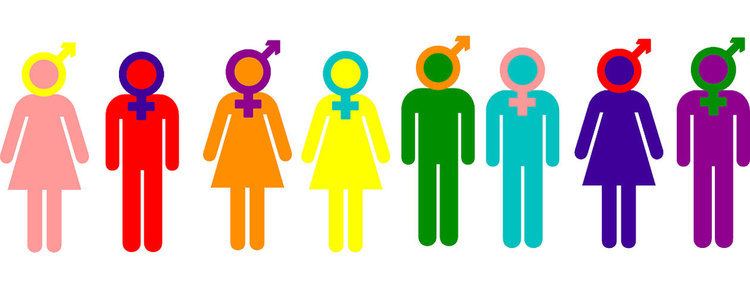 | ||
Similar Trans man, Trans woman, Third gender | ||
The gender binary, also referred to as gender binarism (sometimes shortened to just binarism), is the classification of sex and gender into two distinct, opposite and disconnected forms of masculine and feminine. Gender binary is one general type of a gender system. Gender binary is one of the core principles of genderism; it describes a social boundary that discourages people from crossing or mixing gender roles, and from identifying with more than two forms of gender expression. Sometimes in this binary model, "sex", "gender" and "sexuality" are assumed by default to align. For example, when a male is born, gender binarism assumes the male will be masculine in appearance, character traits, and behavior, including having a heterosexual attraction to females. Gender binarism is only one belief regarding gender. Other groups believe that sex and gender can differ in individuals, while still disagreeing with the idea that gender is non-binary.
Contents
General
The term gender binary describes the system in which a society splits its members into one of two sets of gender roles, gender identities and attributes based on reproductive organs. In the case of people born with organs that fall outside this system (intersex people), enforcement of the binary usually includes coercive surgical gender reassignment. Gender roles are a major aspect of the gender binary. Gender roles shape and constrain an individual's life experiences, impacting aspects of self-expression ranging from clothing choices to occupation. Traditional gender roles continue to be enforced by the media, religion and educational, political and other cultural and social systems. Major religions such as Islam and Catholicism, in particular, act as authorities for gender roles. Islam, for example, teaches that mothers are the primary care givers to their children and Catholics only allow males to serve as their priests.
Gender binaries exist as a means of bringing order, though some people, such as Riki Wilchins in GenderQueer: Voices from Beyond the Sexual Binary, argue that gender binaries divide and polarize society.
Worldwide, there are many individuals and even several subcultures that can be considered exceptions to the gender binary or specific transgender identities. In addition to individuals whose bodies are naturally intersex, there are also specific social roles that involve aspects of both or neither gender. These include the Two-Spirited Native Americans and hijra of India. In the contemporary West, genderqueer people break the gender binary by refusing terms like "male" and "female". Transsexuals have a unique place in relation to the gender binary. In some cases, their gender expression aligns with their sex. Attempting to conform to societal expectations for their gender, transsexuals may opt for surgery, hormones, or both, which according to Jason Cromwell in Queering the Binaries: Transsituated Identities, Bodies, and Sexualities, can be difficult if the individual does not "pass" as cisgender.
Limitations
Many feminist scholars have contested the existence of a clear gender binary. Judith Lorber explains the problem of failing to question dividing people into these two groups “even though they often find more significant within-group differences than between-group differences.” Lorber argues that this corroborates the fact that the gender binary is arbitrary and leads to false expectations of both genders. Instead, there is growing support for the possibility of utilizing additional categories that compare people without "prior assumptions about who is like whom". By allowing for a more fluid approach to gender, people will be able to better identify themselves however they choose and scholarly research will find different similarities and differences.
Rejection
A person can exhibit both traits that were rendered exclusive to "girl". Anne Fausto-Sterling suggests a classification of 23 sexes and a move away from the socially constructed gender binary classification of male and female. In her paper "The Five Sexes: Why Male and Female Are Not Enough", she discusses the existence of intersex people, individuals possessing a combination of male and female sexual characteristics, who are seen as deviations from the norm and who frequently undergo coercive surgery at a very young age in order to maintain the two-gender system. The existence of these individuals challenges the standards of gender binaries and put into question society's role in constructing gender. Fausto-Sterling indicates that modern practitioners encourage the idea that gender is a cultural construct and concludes that, "we are moving from an era of sexual dimorphism to one of variety beyond the number 2."
